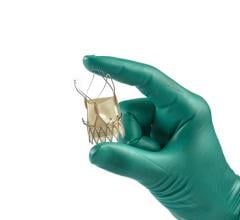
February 16, 2017 — Western Connecticut Health Network (WCHN) cardiothoracic surgeons Cary Passik, M.D., and Robert Gallagher, M.D., were the first in Connecticut to implant the Edwards Intuity Elite sutureless aortic valve in two patients at Danbury Hospital. This new technology in aortic valve replacement (AVR) surgery presents a safe and effective option for patients with severe aortic valve disease. The valves were implanted using the Edwards Intuity valve system, a rapid deployment device approved by the U.S. Food and Drug Administration (FDA) in August 2016.
The American Heart Association estimates that more than 5 million Americans are diagnosed with heart valve disease each year. While the disease can occur in any combination of the four heart valves, the aortic and mitral valves are the most commonly affected.
Aortic stenosis mainly affects older people due to a build-up of calcium on the valve’s leaflets. Over a period of time, the aortic valve leaflets stiffen and do not completely open, blocking the normal flow of blood. Some of the symptoms associated with aortic stenosis include dizziness or fainting, shortness of breath, chest pressure or pain. Without treatment, the symptoms worsen over time and may lead to death within a few years. Treatment for valve disease depends on how much disease is in the valve.
The Edwards Intuity Elite valve is built upon the Perimount valve, which has been widely used for more than 20 years. The valve also uses technology from transcatheter heart valves to simplify placement and shorten the duration of the surgery. The Intuity valve differs from standard heart valves by only needing three guiding sutures for placement, instead of 12-15 sutures.
Passik said, “Because the valves are not sutured in place, fewer steps are necessary, which translates to less time the heart is stopped and the patient is on the heart-lung machine.”
“The cutting-edge treatment allows us to implant the aortic valve faster, thereby allowing more time to complete other procedures conducted simultaneously with the implantation,” said Gallagher, chief of cardiothoracic surgery. “We are very pleased to offer our patients another less invasive treatment option in AVR surgery.”
For more information: www.edwards.com


 October 23, 2024
October 23, 2024 








